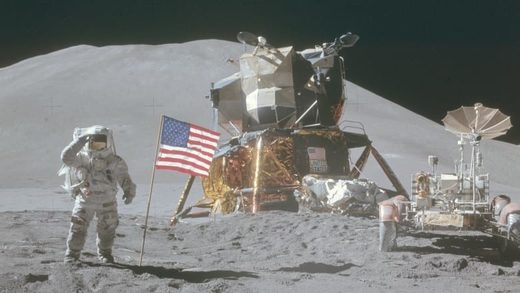
© NASA
The Apollo 15 mission was the fourth lunar landing and launched on July 26, 1971.
It may have been one giant leap for man, but those steps may have consequences for mankind.
The presence of astronauts on the moon caused an unexpected warming of its subsurface temperatures for a period of time in the 1970s,
a new study has found after delving into "lost" tapes from the Apollo missions.
In 1971 and 1972, NASA deployed sensors on the moon during the Apollo 15 and 17 missions in an effort to measure the moon's surface and subsurface temperatures - a project dubbed the heat flow experiment.
Data was collected and beamed back down to Earth until 1977, where scientists were baffled by the gradual warming of the moon's surface being read by the sensors.
NASA ultimately abandoned the research due to a lack of funding, and only some of the tapes were archived, with the others assumed lost, leaving scientists unable to analyze it further.
But those missing tapes were found recently in the National Archives, said study co-author Walter Kiefer, a senior staff scientist at the Lunar and Planetary Institute. He and his team spent years recovering and interpreting the data in order to pinpoint the source of the warming.
Specifically, the decades-old data showed the moon's subsurface temperatures - in some areas as deep as three metres - increased from 1.6 C to 3.5 C over the roughly six-year period measurements were being taken.
Bright vs. darkThe moon consists primarily of two different types of rock: anorthosite and basalt. Anorthosite is light in colour and makes the moon bright, while basalt, which is common on Earth, is darker and appears as the maria, or "seas," on the moon.
Lighter-coloured surfaces reflect more energy outward, while darker surfaces absorb energy.
Using photos from the extremely high-resolution camera aboard the Lunar Reconnaissance Orbiter (LRO) orbiting the moon, the scientists determined that as astronauts walked or drove on the moon, it disturbed the anorthosite lunar soil - also known as regolith - left over from billions of years of bombardment from space rocks.
That disruption exposed the darker soil, which then absorbed more of the sun's energy and ultimately raised the moon's temperatures.
"You can actually see the astronauts tracks, where they walked," Kiefer said. "And we can see ... where they scuffed dirt up - and what it leaves behind is a darker path. In other words, the astronauts walking on the moon changed the structure of the regolith ... in such a way that made it a little bit darker."
Over years, that energy propagated downward and deeper into the lunar surface, which is what appeared on the newly acquired data record.
Eventually the temperatures would have reached an equilibrium as absorption stopped, said Kiefer, noting it may have already happened.
Since Neil Armstrong took those historic first steps on July 20, 1969, 11 others have walked on the moon.
Future visitsThe findings are a reminder of how human activity can disrupt a system that has been in isolation for billions of years, Kiefer said, which could provide valuable information for future lunar - and potentially Mars - missions.
"The overall effect on the moon of having even a few hundred people isn't going to be that big of a deal," Kiefer said. "The moon will be just fine if it's two degrees hotter than it is right now."
While a slight change to moon's temperature might not pose a problem, the findings should affect our scientific understanding of our nearest neighbour and the evolution of the solar system as a whole, says planetary scientist Catherine Neish.
"Even on Earth, it's this balance of making progress with science and technology but respecting the system that we were given as human beings," said Neish, who works at Western University in London, Ont.
"We're obviously changing Earth in significant ways, and I'm sure we would do that on other planets as well."
And while there's no life on the moon, Neish said human disruption is still altering a pristine environment that contains history and potential clues to the origin of life on Earth.
"Should we morally be concerned about that?" she said. "We are affecting nature in a very substantial way and we're making questions that we want to answer about the fundamental properties of the universe more difficult to answer."
Reader Comments